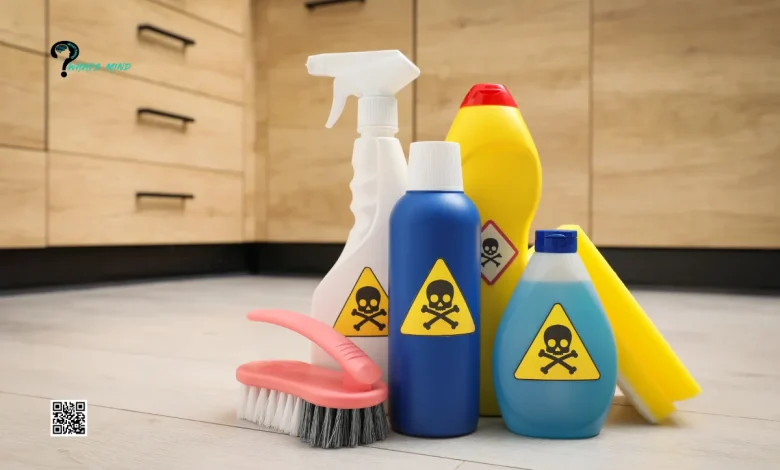10 Warning Signs Of Mold Toxicity: Understanding, Mold Toxicity, Allergic Reaction, Causes, Precautions

What is Mold and their most common 10 warning signs of mold toxicity? Mold is a typical kind of fungus that enlarges in wet and humid areas. It can be present in homes, schools, and workplaces. It also leads to numerous health issues such as allergic reactions, lung-related problems, and even dangerous elements.
Mold toxicity particularly arises when a person is exposed to toxic mold spores for a long period. But some types of mold are less dangerous, others can create toxins that can have dangerous effects on our health. When these harmful chemicals or Mycotoxins are breathed in or ingested can result in numerous signs and health problems.
In this guide, we will look over 10 warning signs of mold toxicity, understanding, Mold allergy reaction, causes, and prevention measures.
| 10 Warning Signs Of Mold Toxicity | ||
| One | Sleep Disturbance | |
| Two | Nasal Congestion | |
| Three | Psychological & Mood Swings | |
| Four | Digestive Problems | |
| Five | Fatigue & Mineral Deficiency | |
| Six | Continuous Headaches & Migraines | |
| Seven | Neurological & Cognitive Problems | |
| Eight | Muscle Soreness & Joint Pain | |
| Nine | Tinnitus | |
| Ten | Difficult To Diagnose Pain |
Table of Contents
10 Warning Signs Of Mold Toxicity
What are the signs and symptoms of Mold Toxicity? Prolonged contact with mold can cause a large number of health problems, some of which can be severe if not treated properly. The warning signs can differ between individuals, but 10 warning signs of mold toxicity are very common, let’s uncover them together:
Sleep Disturbance
Mold toxicity can result in insomnia for instance trouble sleeping, waking all night, and reduced timing of required sleeping.
Nasal Congestion
Nasal and sinus infections are obvious signs of mold toxicity. Additionally, you are sensitive to fungal infection when vulnerable to mold. Particularly when you inhale the smell of the damp and moldy smell of indoor mold infections.
Psychological & Mood Swings
After mold exposure, you are suffering from depression and anxiety, as well as it also affects your brain’s neurotransmitter functions.

Mycotoxins or harmful chemicals are thought to disturb normal brain functions and affect the activity of neurotransmitters including dopamine and serotonin, resulting in mood swings.
Digestive Problems
The mycotoxins that molds make, when you breathe in or ingest, those harmful chemicals can disturb your digestive system. Many mycotoxins have been proven to negatively change your gut microbiome and weaken the function of the gut lining.
This can result in symptoms such as diarrhea, abdominal pain, nausea, vomiting, intestinal bleeding, and lessened nutrient absorption. Your hunger cycle is also very disturbed and weight can also be changed, sometimes reduced or sometimes increased.
Fatigue & Mineral Deficiency
If you feel tired or weak daily, it could point out mold toxicity. Mold spores can be inserted in the sinuses and move into the lungs resulting in pneumonia, which decreases oxygen intake, leading to repeated fatigue and weakness. Mycotoxins are known to damage mitochondrial function and boost oxidative damage, contributing to weakness.
Continuous Headaches & Migraines
Regular headaches or migraines can be a symptom of mold toxicity. Exposure to mold and the next immune reaction can result in headaches, which may decrease upon leaving a mold-infected environment.
Neurological & Cognitive Problems
Long-term contact with mycotoxins can affect your nervous system and result in many problems including loss of memory, uncertainty, and loss of balance. Additionally, serious issues also occur including neuropathy, dementia, and impairment in intellectual and neural function.
Muscle Soreness & Joint Pain
If you are infected with mold can lead to soreness in muscles and joints. Mold toxicity can affect fungal arthritis, an unusual condition caused by the circulation of a fungal infection to a joint.

Fungal arthritis is commonly caused by a fungus being exposed directly to a joint by trauma or surgery, but it may be likely for an infection from breathed-in mold to move through the blood to a joint, resulting in pain, swelling, and inflammation. This type of infection is initially a danger to those with weakened immune systems.
Tinnitus
Tinnitus is resounding in the ears and this is also a warning sign of mold toxicity. Any hearing problems may be the result of numerous factors regarding mold exposure, such as Autoimmune Inner Ear Disease and pressure alterations produced by recurring infections from toxic mold exposure.
Difficult To Diagnose Pain
Un-diagnosed pain is one of the irritating signs and complicated health problems to live with, quickly because it can be so difficult to navigate and cure. People with mold toxicity usually address a muscular pain likely to fibromyalgia, but it can also be abdominal pain.
Understanding Of 10 Warning Signs Of Mold Toxicity
What is mold toxicity? It is mold poisoning or mycotoxicosis, a term used to explain the severe results of the unveiling of mold and its toxins. When mold fungal seeds are breathed in or ingested, they can cause 10 warning signs of mold toxicity or health issues in many people. These warning signs can change depending on the kind and extent of mold present, plus the individual’s susceptibility to mold toxins.
Brief Overview Of Mold
What is mold, and how does it grow? Molds are fungal infections that grow or spread both outside of the house and inside. They specifically grow in moist, warm, and foggy environments, but stay nearly everywhere. Mold plays an essential role in our biosphere from inhaling and breaking down natural material such as fallen trees and dead leaves, to producing antibiotics including penicillin.
These microspores are a continuous presence in indoor environments and they never grow without humidity. When these fungal seeds spread into the air, we can easily breathe in, ingest, or come into touch with the skin. That’s why they destroy buildings, beauty products, and furniture.
What Is Mold Allergic Reaction
Is mold allergic reaction prompted by mold spores? Yes, an allergic reaction prompted by ingesting or entering Mold spores or their antigenic proteins. The runny or stuffy nose, skin redness, weepy eyes, and Asthma comparable symptoms are major symptoms of mold allergic reaction.

To avoid these symptoms you should seek medical treatment such as taking Allergy shots, Antihistamines, decongestants, and corticosteroids for symptoms easing.
Causes Of Mold Toxicity
What are some causes of mold growth in the biosphere? Mold toxicity is caused by interaction with various types of molds that create mycotoxins. These toxic chemicals take place, where high humidity from water damage, flooding, fogging, water leaks, or water leakage is present.
The forest green mold known as Stachybotrys chartarum is grown with chemicals that are very harmful to our bodies. Here is the list of some additional causes of 10 warning signs of mold toxicity:
Already Present Health Conditions
People with already present health conditions including any allergic reaction, asthma, or weak immune systems, are more vulnerable to the dangerous outcomes of mold.
Impaired Immune System
A feeble immune system can make it challenging for the body to defend against the outcomes of mold toxins, resulting in more serious symptoms.
Unveiling To Toxic Mold
Some molds generate more dangerous toxic chemicals than others. Exposure to these molds can cause serious health problems, such as black mold poisoning.
Ecological Factors
Mold stay in damp or humid environments. That’s why damp places, poor airflow, and water damage are more common to spread mold, which can cause mold toxicity.
How Can We Stop Mold Toxicity?
Everyone is wondering about one question, how can we stop the 10 warning signs of mold toxicity that typically arise from mold spores? So the answer is very simple to prevent mold toxicity you should manage the moisture levels in your living space and working areas because mold stays in damp areas. Here are some additional proactive steps:
Manage Indoor Dampness
Your first goal is to manage indoor humidity between 35- 50 percent. Always apply dehumidifiers in wet areas, particularly during rainy seasons.
Examine Your Home Ventilation
Make sure that your house has proper airflow, particularly in areas like the bathroom, kitchen, and laundry room that can produce a lot of wetness. Effectively air circulation and dehumidifiers can help decrease the possibility of mold growth.
Repair The Holes & Cracks
Daily examine your house for leaks in the ceiling, walls, and pipes. Seal the gap or any leaks immediately.
Dry Humid Places Instantly
Hygienic and dry any humid places within 24 to 48 hours to stop mold toxicity. Mold stays in wet areas to grow, so removing the humidity can limit mold.
Avoid Fitting Carpet In Water-Used Areas
Try to stop fitting carpets in bathrooms or garden areas where water is used daily or moisture damage is very likely.
Conclusion
In conclusion, 10 warning signs of mold toxicity cause a variety of health issues, and it is essential to be careful of the warning signs that are written above. If you have a feeling that you have been infected with mold, it is crucial to look for medical care and take precautions to stop increased vulnerability.
This can include fungus treatment, opening windows, and utilizing air cleaners. By being observant and holding a timely intervention, you can save yourself and your family members from the dangerous effects of mold toxicity. Overall, to maintain wellness ask for medical treatment and homemade remedies to keep out from moldy environments.
Lastly, you get comprehensive information about 10 warning signs of mold toxicity in this article. Are you also facing mold toxicity? Then please share your personal experience and remedies with us. Thank You!
FAQs On 10 Warning Signs Of Mold Toxicity
1: How do I know if I have mold toxicity?
The best straightforward way to test for mold toxicity is a pee test that examines metabolic byproducts of mold, mycotoxins, and glutathione levels which can be decreased when you are unprotected from mold.
2: Can I remove a mold myself?
Yes, you can by utilizing some useful products. For instance, you can use baking soda, vinegar, Tea tree oil, hydrogen peroxide, and detergent to destroy mold. The best method is to pour the vinegar into a spray bottle and spray in infected places for one hour to get better results.
3: How can I test for mold at home?
A speedy test for mold can be possible when you dip a wipe in diluted bleach like one portion of bleach and 16 portions of water mix it well and put it on the wall. If the touch instantly lightens or keeps coming again after cleaning means it is mold infected place.
- Are Aluminum Pans Safe? Understanding, Health Risks, Alternatives, Prevention Strategies
- What Is Commonly Misdiagnosed As Pink Eye? Conjunctivitis, Myths, Preventive Measures & Doctor’s Consultation
- How Doxycycline Ruined My Life, Side Effects, Case Study, Reviews
For more information, visit Whatsmind.com




